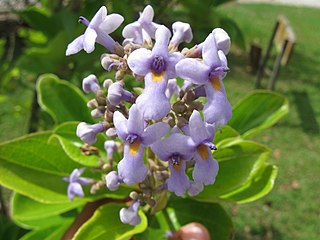
Hypoxis decumbens is a species of plant in the Hypoxidaceae, considered by some authors to be included within the Liliaceae or Amaryllidaceae. The species is widespread across South America, Central America, Mexico, and the West Indies.

Dalechampia dioscoreifolia is a species of plant in the family Euphorbiaceae first described in 1841. It is native to Central America and northern and western South America.
Triuris hyalina is a species in genus Triuris. It is a tiny flowering plant no more than a few cm tall, lacking chlorophyll and obtaining its nutrients from fungi in the soil. It is known from Brazil, Suriname, Guyana, Colombia, Venezuela.
Thoracocarpus is a genus of plants first described as a genus in 1958. It contains only one known species, Thoracocarpus bissectus a hemiepiphytic vine. It is native to Costa Rica, Panama, Cuba, Trinidad and Tobago, and South America.

Cycnoches haagii is a species of orchid native to tropical South America.

Aechmea angustifolia is a plant species in the genus Aechmea. This species is native to Central America and northern South America.
Aechmea corymbosa is a plant species in the genus Aechmea. This species is native to Venezuela, Colombia, Peru, Brazil and Ecuador.
Guzmania brasiliensis is a plant species in the genus Guzmania. This species is native to northern Brazil, Peru, Colombia, Venezuela and Ecuador.

Trizeuxis is a monotypic genus of flowering plants from the orchid family, Orchidaceae. The sole species is Trizeuxis falcata, native to the American Tropics.
Euterpe catinga is a palm species in the genus Euterpe. It is found in forests of a dry, sandy soil and very peculiar vegetation, known as catinga forests or Campinarana in northern South America.
Maxillaria petiolaris, synonym Hylaeorchis petiolaris, is a species of epiphytic orchids native to northwestern South America. When placed in the genus Hylaeorchis, it was the only species.

Soridium is a genus of myco-heterotrophic plants in the Triuridaceae, lacking chlorophyll and obtaining nutrients from fungi in the soil. It contains only one known species, Soridium spruceanum, native to Brazil, Venezuela, Suriname, French Guiana, Belize and Guatemala.

Cornutia is a genus of plants in the family Lamiaceae, first described in 1753. Species in this genus are native to tropical parts of the Western Hemisphere, including southern Mexico, Central America, the West Indies, and northern South America.

Achlyphila is a genus of plants in the Xyridaceae, first described as a genus in 1960. It contains only one known species, Achlyphila disticha, endemic to the Serranía de la Neblina National Park in the State of Amazonas in southern Venezuela, very close to the border with Brazil.
Aratitiyopea is a monotypic genus of flowering plants, in the family Xyridaceae containing the single species Aratitiyopea lopezii. The genus was erected and described in 1984. This species is native to northern South America.

Evodianthus is a genus of plants first described as a genus in 1857. It contains only one known species, Evodianthus funifer, native to Trinidad & Tobago, Central America and northern South America.
Diploon is a genus of plant in the family Sapotaceae described as a genus in 1946.

Thurnia is a group of herbaceous plants described as a genus in 1883.
Brickellia diffusa is a Latin American species of flowering plants in the family Asteraceae. It is widespread across much of South America, Central America, Mexico, Galápagos, and the West Indies. Its distribution stretches from Sonora and Tamaulipas in northern Mexico to Jujuy in northern Argentina.
Paul Edward Berry is an American botanist and curator. He is Director of the Wisconsin State Herbarium.










